Global Business Report: Impact of Globalisation on Procter & Gamble
VerifiedAdded on 2020/11/23
|13
|2761
|282
Report
AI Summary
This report provides a comprehensive analysis of global business operations, with a specific focus on The Procter & Gamble Company (P&G). The report begins with an introduction to global business and the company profile of P&G, highlighting its diverse product portfolio and financial performance. The core of the report examines the key factors driving globalisation, including cost, market, environment, and competition. It then delves into the influence of globalisation on P&G's organisational governance, leadership, structure, culture, and functions, using examples of how P&G adapted its strategies to new markets. The report also evaluates the impact of ethical and sustainable globalisation on P&G's operations. Furthermore, it explores effective decision-making strategies, identifies barriers to internationalisation, and offers recommendations for overcoming these challenges. The report concludes with a summary of the key findings and insights into the complexities of operating in a globalised business environment.
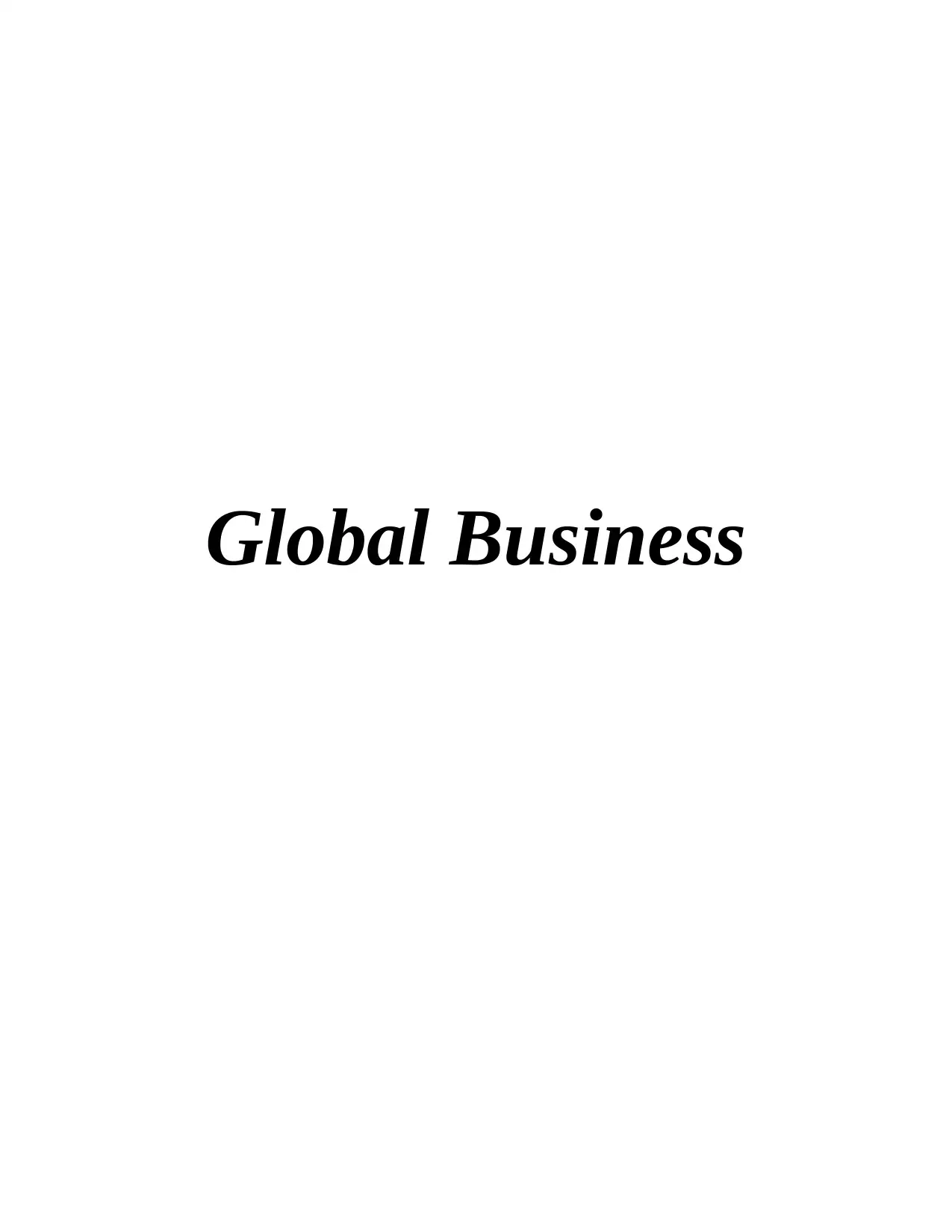
Global Business
Paraphrase This Document
Need a fresh take? Get an instant paraphrase of this document with our AI Paraphraser
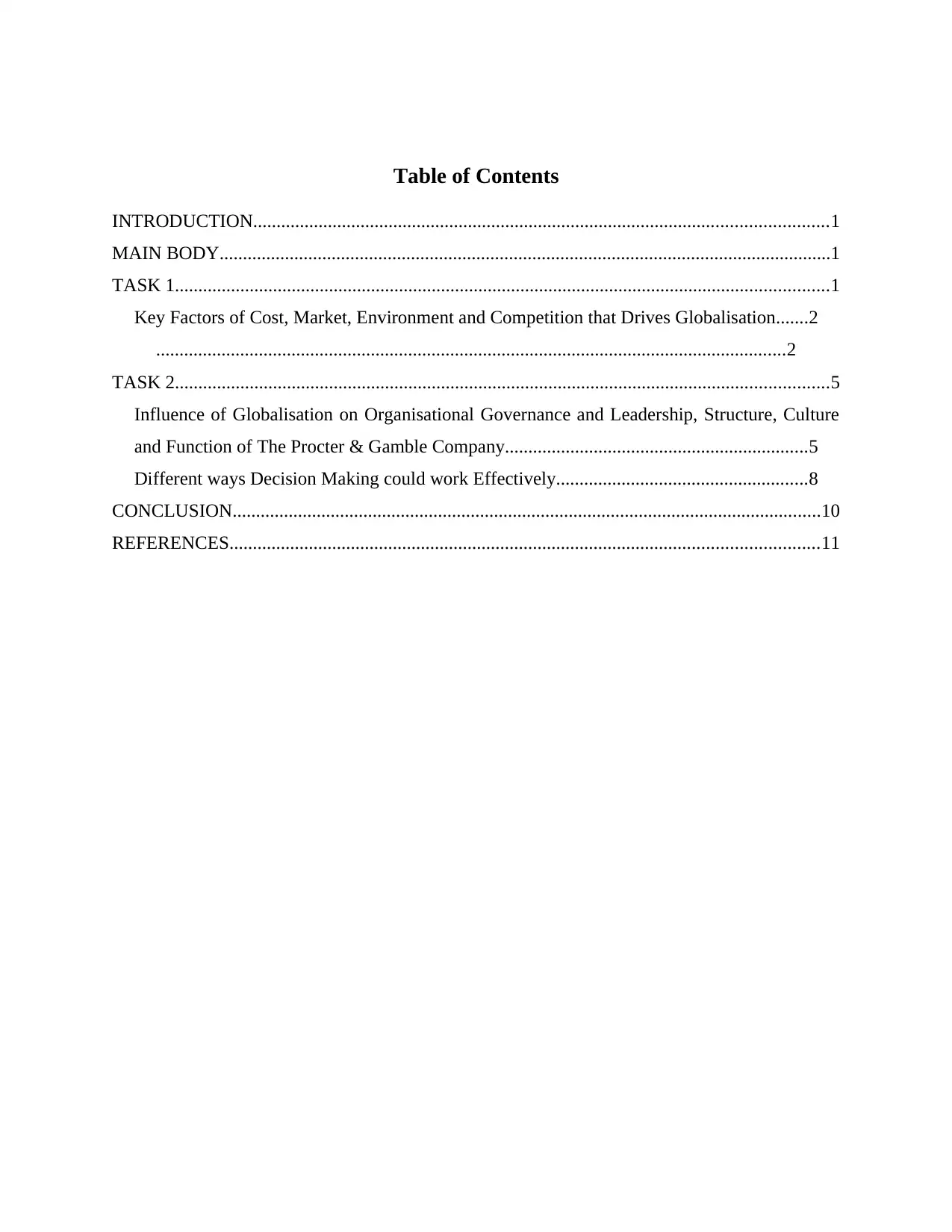
Table of Contents
INTRODUCTION...........................................................................................................................1
MAIN BODY...................................................................................................................................1
TASK 1............................................................................................................................................1
Key Factors of Cost, Market, Environment and Competition that Drives Globalisation.......2
.......................................................................................................................................2
TASK 2............................................................................................................................................5
Influence of Globalisation on Organisational Governance and Leadership, Structure, Culture
and Function of The Procter & Gamble Company.................................................................5
Different ways Decision Making could work Effectively......................................................8
CONCLUSION..............................................................................................................................10
REFERENCES..............................................................................................................................11
INTRODUCTION...........................................................................................................................1
MAIN BODY...................................................................................................................................1
TASK 1............................................................................................................................................1
Key Factors of Cost, Market, Environment and Competition that Drives Globalisation.......2
.......................................................................................................................................2
TASK 2............................................................................................................................................5
Influence of Globalisation on Organisational Governance and Leadership, Structure, Culture
and Function of The Procter & Gamble Company.................................................................5
Different ways Decision Making could work Effectively......................................................8
CONCLUSION..............................................................................................................................10
REFERENCES..............................................................................................................................11
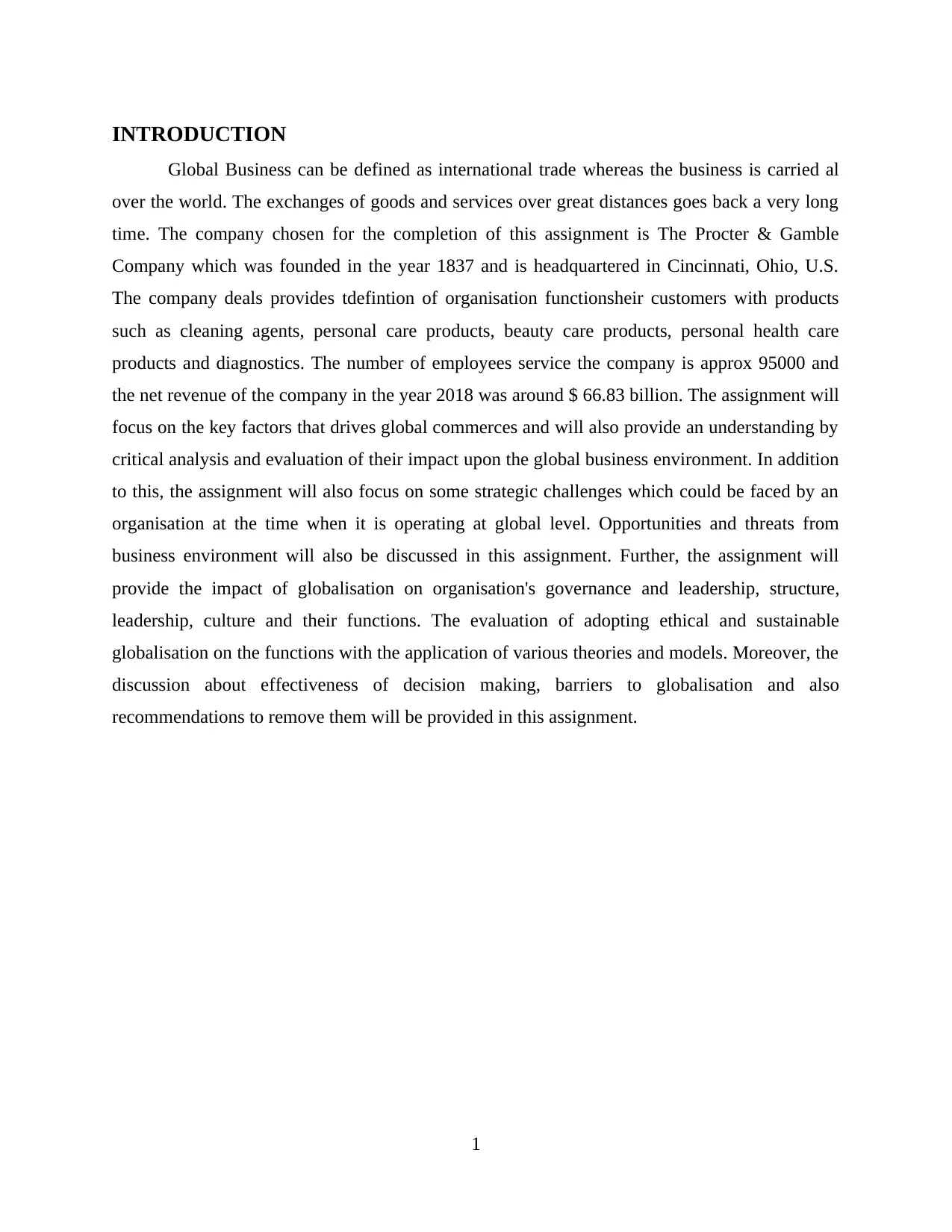
INTRODUCTION
Global Business can be defined as international trade whereas the business is carried al
over the world. The exchanges of goods and services over great distances goes back a very long
time. The company chosen for the completion of this assignment is The Procter & Gamble
Company which was founded in the year 1837 and is headquartered in Cincinnati, Ohio, U.S.
The company deals provides tdefintion of organisation functionsheir customers with products
such as cleaning agents, personal care products, beauty care products, personal health care
products and diagnostics. The number of employees service the company is approx 95000 and
the net revenue of the company in the year 2018 was around $ 66.83 billion. The assignment will
focus on the key factors that drives global commerces and will also provide an understanding by
critical analysis and evaluation of their impact upon the global business environment. In addition
to this, the assignment will also focus on some strategic challenges which could be faced by an
organisation at the time when it is operating at global level. Opportunities and threats from
business environment will also be discussed in this assignment. Further, the assignment will
provide the impact of globalisation on organisation's governance and leadership, structure,
leadership, culture and their functions. The evaluation of adopting ethical and sustainable
globalisation on the functions with the application of various theories and models. Moreover, the
discussion about effectiveness of decision making, barriers to globalisation and also
recommendations to remove them will be provided in this assignment.
1
Global Business can be defined as international trade whereas the business is carried al
over the world. The exchanges of goods and services over great distances goes back a very long
time. The company chosen for the completion of this assignment is The Procter & Gamble
Company which was founded in the year 1837 and is headquartered in Cincinnati, Ohio, U.S.
The company deals provides tdefintion of organisation functionsheir customers with products
such as cleaning agents, personal care products, beauty care products, personal health care
products and diagnostics. The number of employees service the company is approx 95000 and
the net revenue of the company in the year 2018 was around $ 66.83 billion. The assignment will
focus on the key factors that drives global commerces and will also provide an understanding by
critical analysis and evaluation of their impact upon the global business environment. In addition
to this, the assignment will also focus on some strategic challenges which could be faced by an
organisation at the time when it is operating at global level. Opportunities and threats from
business environment will also be discussed in this assignment. Further, the assignment will
provide the impact of globalisation on organisation's governance and leadership, structure,
leadership, culture and their functions. The evaluation of adopting ethical and sustainable
globalisation on the functions with the application of various theories and models. Moreover, the
discussion about effectiveness of decision making, barriers to globalisation and also
recommendations to remove them will be provided in this assignment.
1
⊘ This is a preview!⊘
Do you want full access?
Subscribe today to unlock all pages.

Trusted by 1+ million students worldwide
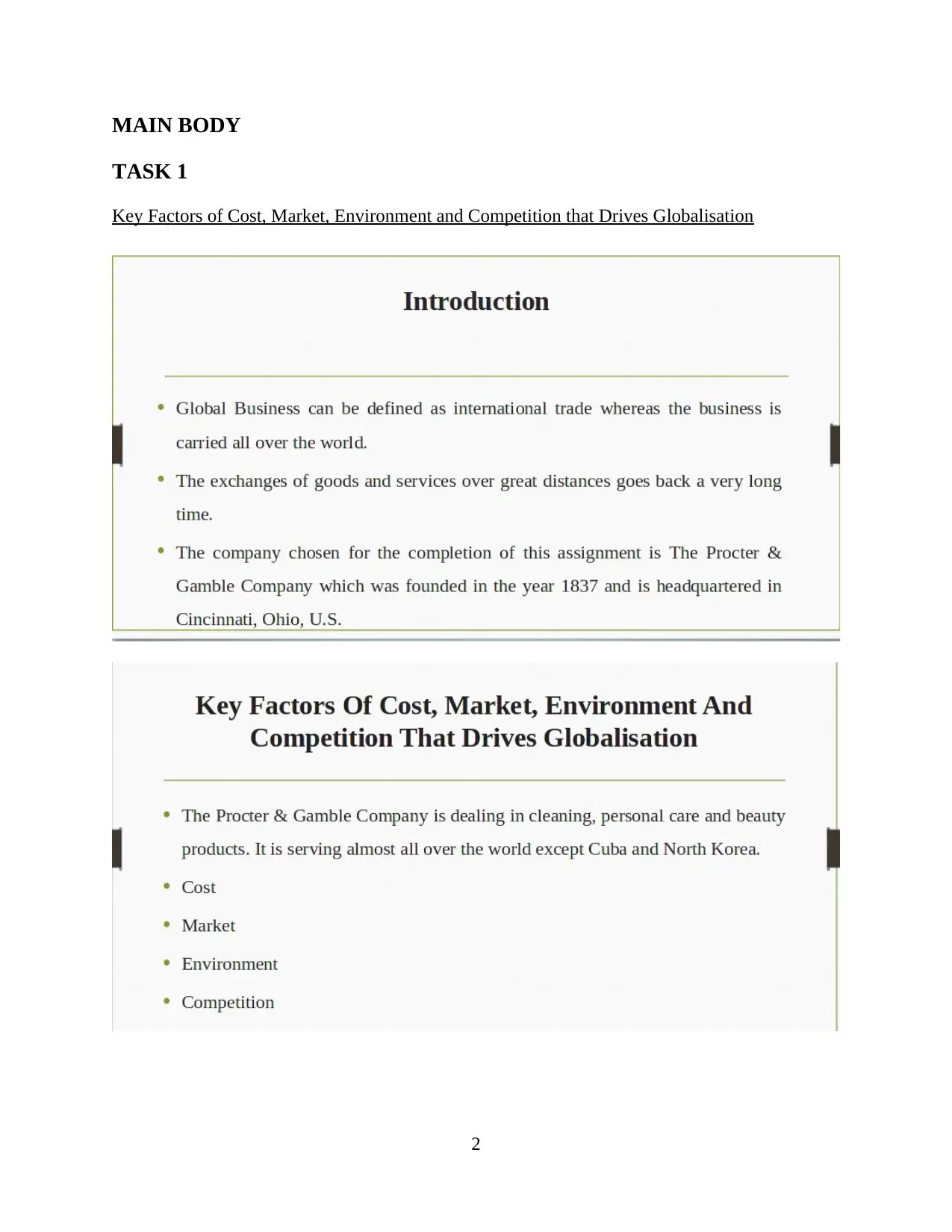
MAIN BODY
TASK 1
Key Factors of Cost, Market, Environment and Competition that Drives Globalisation
2
TASK 1
Key Factors of Cost, Market, Environment and Competition that Drives Globalisation
2
Paraphrase This Document
Need a fresh take? Get an instant paraphrase of this document with our AI Paraphraser
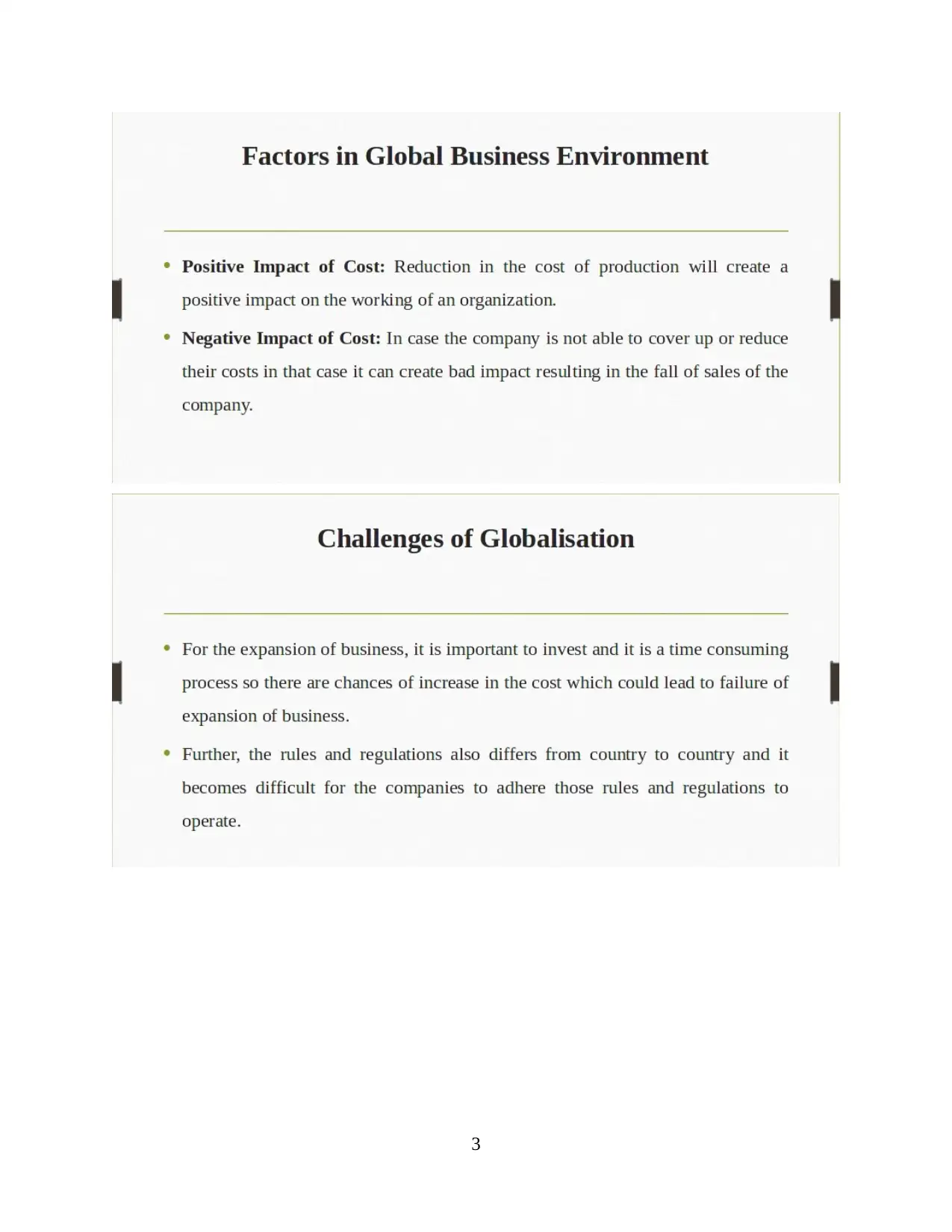
3
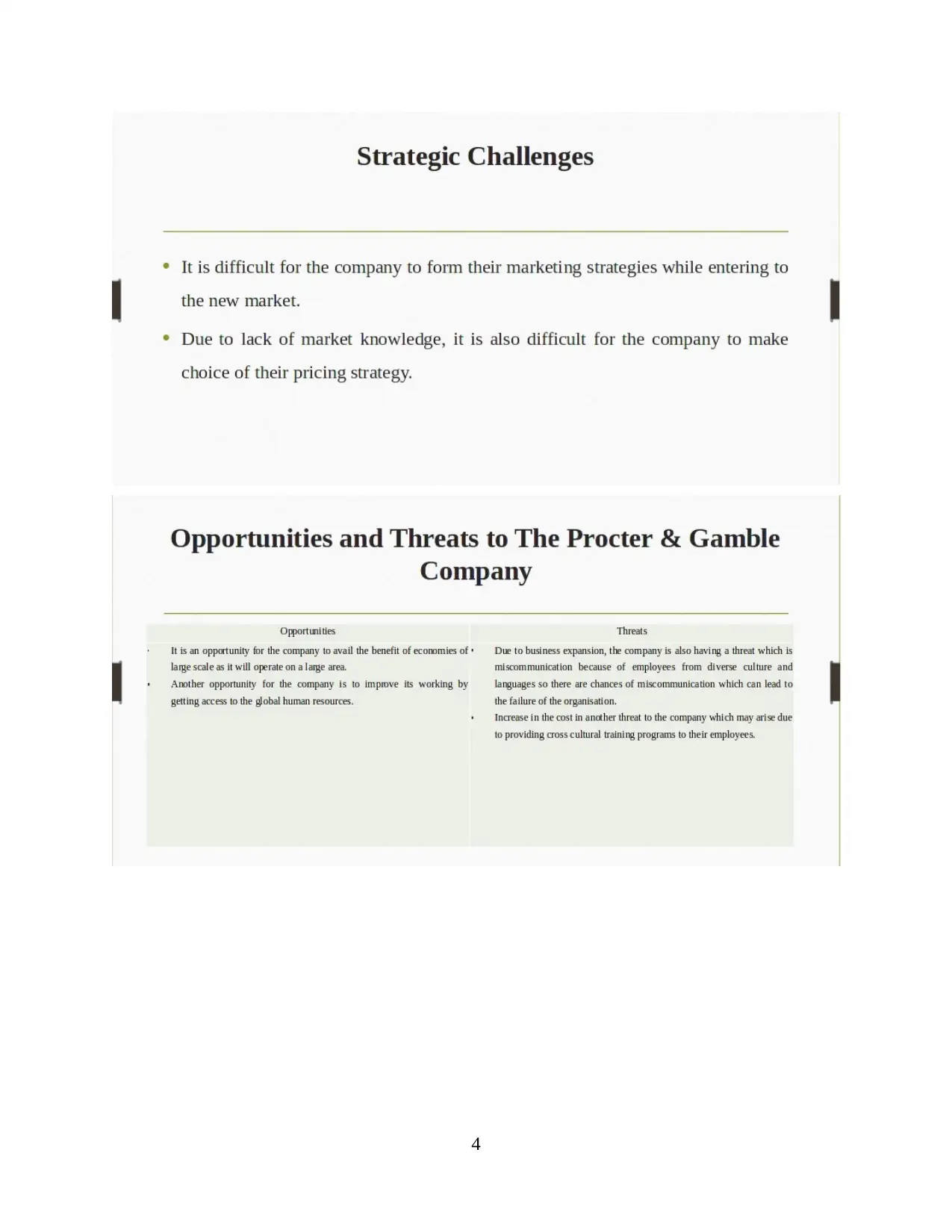
4
⊘ This is a preview!⊘
Do you want full access?
Subscribe today to unlock all pages.

Trusted by 1+ million students worldwide
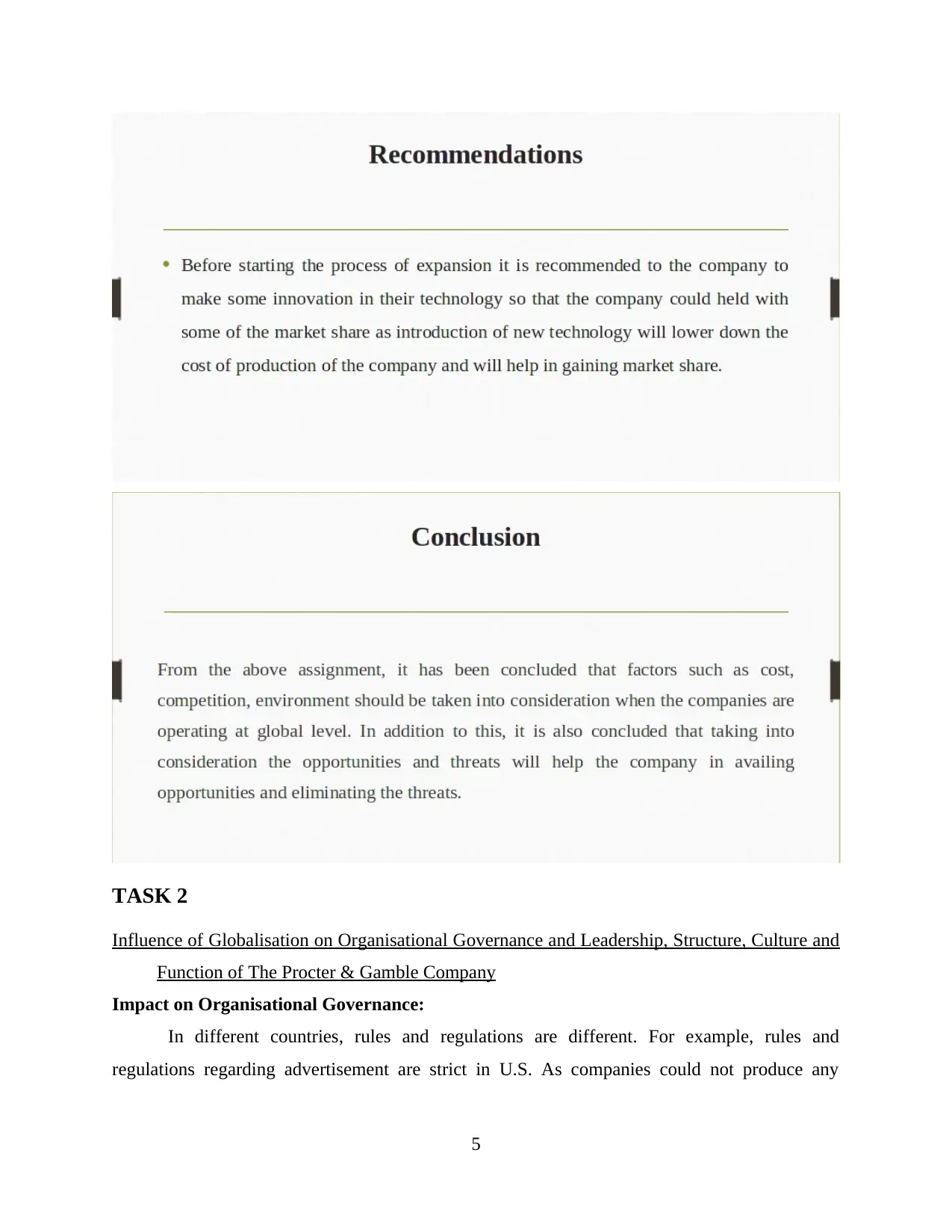
TASK 2
Influence of Globalisation on Organisational Governance and Leadership, Structure, Culture and
Function of The Procter & Gamble Company
Impact on Organisational Governance:
In different countries, rules and regulations are different. For example, rules and
regulations regarding advertisement are strict in U.S. As companies could not produce any
5
Influence of Globalisation on Organisational Governance and Leadership, Structure, Culture and
Function of The Procter & Gamble Company
Impact on Organisational Governance:
In different countries, rules and regulations are different. For example, rules and
regulations regarding advertisement are strict in U.S. As companies could not produce any
5
Paraphrase This Document
Need a fresh take? Get an instant paraphrase of this document with our AI Paraphraser
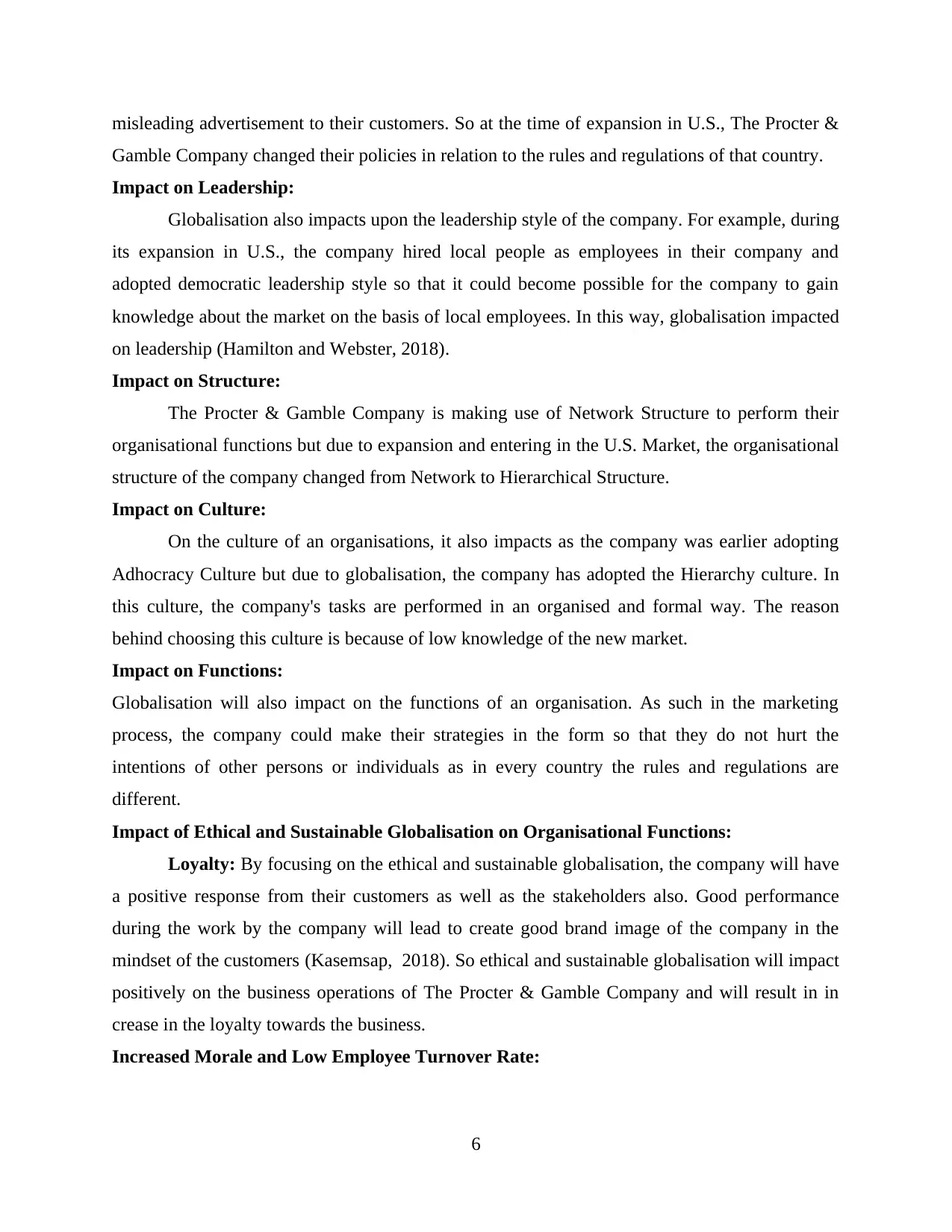
misleading advertisement to their customers. So at the time of expansion in U.S., The Procter &
Gamble Company changed their policies in relation to the rules and regulations of that country.
Impact on Leadership:
Globalisation also impacts upon the leadership style of the company. For example, during
its expansion in U.S., the company hired local people as employees in their company and
adopted democratic leadership style so that it could become possible for the company to gain
knowledge about the market on the basis of local employees. In this way, globalisation impacted
on leadership (Hamilton and Webster, 2018).
Impact on Structure:
The Procter & Gamble Company is making use of Network Structure to perform their
organisational functions but due to expansion and entering in the U.S. Market, the organisational
structure of the company changed from Network to Hierarchical Structure.
Impact on Culture:
On the culture of an organisations, it also impacts as the company was earlier adopting
Adhocracy Culture but due to globalisation, the company has adopted the Hierarchy culture. In
this culture, the company's tasks are performed in an organised and formal way. The reason
behind choosing this culture is because of low knowledge of the new market.
Impact on Functions:
Globalisation will also impact on the functions of an organisation. As such in the marketing
process, the company could make their strategies in the form so that they do not hurt the
intentions of other persons or individuals as in every country the rules and regulations are
different.
Impact of Ethical and Sustainable Globalisation on Organisational Functions:
Loyalty: By focusing on the ethical and sustainable globalisation, the company will have
a positive response from their customers as well as the stakeholders also. Good performance
during the work by the company will lead to create good brand image of the company in the
mindset of the customers (Kasemsap, 2018). So ethical and sustainable globalisation will impact
positively on the business operations of The Procter & Gamble Company and will result in in
crease in the loyalty towards the business.
Increased Morale and Low Employee Turnover Rate:
6
Gamble Company changed their policies in relation to the rules and regulations of that country.
Impact on Leadership:
Globalisation also impacts upon the leadership style of the company. For example, during
its expansion in U.S., the company hired local people as employees in their company and
adopted democratic leadership style so that it could become possible for the company to gain
knowledge about the market on the basis of local employees. In this way, globalisation impacted
on leadership (Hamilton and Webster, 2018).
Impact on Structure:
The Procter & Gamble Company is making use of Network Structure to perform their
organisational functions but due to expansion and entering in the U.S. Market, the organisational
structure of the company changed from Network to Hierarchical Structure.
Impact on Culture:
On the culture of an organisations, it also impacts as the company was earlier adopting
Adhocracy Culture but due to globalisation, the company has adopted the Hierarchy culture. In
this culture, the company's tasks are performed in an organised and formal way. The reason
behind choosing this culture is because of low knowledge of the new market.
Impact on Functions:
Globalisation will also impact on the functions of an organisation. As such in the marketing
process, the company could make their strategies in the form so that they do not hurt the
intentions of other persons or individuals as in every country the rules and regulations are
different.
Impact of Ethical and Sustainable Globalisation on Organisational Functions:
Loyalty: By focusing on the ethical and sustainable globalisation, the company will have
a positive response from their customers as well as the stakeholders also. Good performance
during the work by the company will lead to create good brand image of the company in the
mindset of the customers (Kasemsap, 2018). So ethical and sustainable globalisation will impact
positively on the business operations of The Procter & Gamble Company and will result in in
crease in the loyalty towards the business.
Increased Morale and Low Employee Turnover Rate:
6
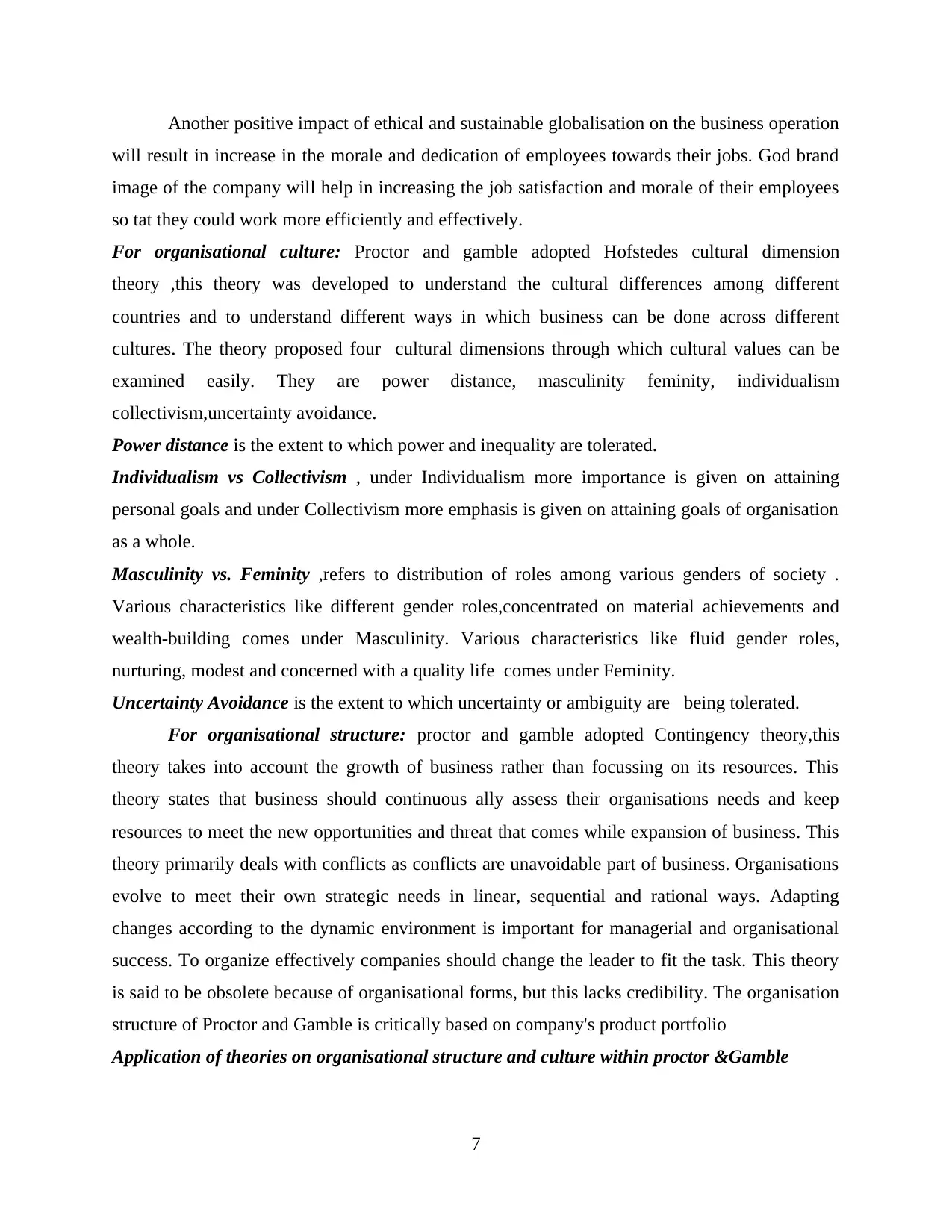
Another positive impact of ethical and sustainable globalisation on the business operation
will result in increase in the morale and dedication of employees towards their jobs. God brand
image of the company will help in increasing the job satisfaction and morale of their employees
so tat they could work more efficiently and effectively.
For organisational culture: Proctor and gamble adopted Hofstedes cultural dimension
theory ,this theory was developed to understand the cultural differences among different
countries and to understand different ways in which business can be done across different
cultures. The theory proposed four cultural dimensions through which cultural values can be
examined easily. They are power distance, masculinity feminity, individualism
collectivism,uncertainty avoidance.
Power distance is the extent to which power and inequality are tolerated.
Individualism vs Collectivism , under Individualism more importance is given on attaining
personal goals and under Collectivism more emphasis is given on attaining goals of organisation
as a whole.
Masculinity vs. Feminity ,refers to distribution of roles among various genders of society .
Various characteristics like different gender roles,concentrated on material achievements and
wealth-building comes under Masculinity. Various characteristics like fluid gender roles,
nurturing, modest and concerned with a quality life comes under Feminity.
Uncertainty Avoidance is the extent to which uncertainty or ambiguity are being tolerated.
For organisational structure: proctor and gamble adopted Contingency theory,this
theory takes into account the growth of business rather than focussing on its resources. This
theory states that business should continuous ally assess their organisations needs and keep
resources to meet the new opportunities and threat that comes while expansion of business. This
theory primarily deals with conflicts as conflicts are unavoidable part of business. Organisations
evolve to meet their own strategic needs in linear, sequential and rational ways. Adapting
changes according to the dynamic environment is important for managerial and organisational
success. To organize effectively companies should change the leader to fit the task. This theory
is said to be obsolete because of organisational forms, but this lacks credibility. The organisation
structure of Proctor and Gamble is critically based on company's product portfolio
Application of theories on organisational structure and culture within proctor &Gamble
7
will result in increase in the morale and dedication of employees towards their jobs. God brand
image of the company will help in increasing the job satisfaction and morale of their employees
so tat they could work more efficiently and effectively.
For organisational culture: Proctor and gamble adopted Hofstedes cultural dimension
theory ,this theory was developed to understand the cultural differences among different
countries and to understand different ways in which business can be done across different
cultures. The theory proposed four cultural dimensions through which cultural values can be
examined easily. They are power distance, masculinity feminity, individualism
collectivism,uncertainty avoidance.
Power distance is the extent to which power and inequality are tolerated.
Individualism vs Collectivism , under Individualism more importance is given on attaining
personal goals and under Collectivism more emphasis is given on attaining goals of organisation
as a whole.
Masculinity vs. Feminity ,refers to distribution of roles among various genders of society .
Various characteristics like different gender roles,concentrated on material achievements and
wealth-building comes under Masculinity. Various characteristics like fluid gender roles,
nurturing, modest and concerned with a quality life comes under Feminity.
Uncertainty Avoidance is the extent to which uncertainty or ambiguity are being tolerated.
For organisational structure: proctor and gamble adopted Contingency theory,this
theory takes into account the growth of business rather than focussing on its resources. This
theory states that business should continuous ally assess their organisations needs and keep
resources to meet the new opportunities and threat that comes while expansion of business. This
theory primarily deals with conflicts as conflicts are unavoidable part of business. Organisations
evolve to meet their own strategic needs in linear, sequential and rational ways. Adapting
changes according to the dynamic environment is important for managerial and organisational
success. To organize effectively companies should change the leader to fit the task. This theory
is said to be obsolete because of organisational forms, but this lacks credibility. The organisation
structure of Proctor and Gamble is critically based on company's product portfolio
Application of theories on organisational structure and culture within proctor &Gamble
7
⊘ This is a preview!⊘
Do you want full access?
Subscribe today to unlock all pages.

Trusted by 1+ million students worldwide
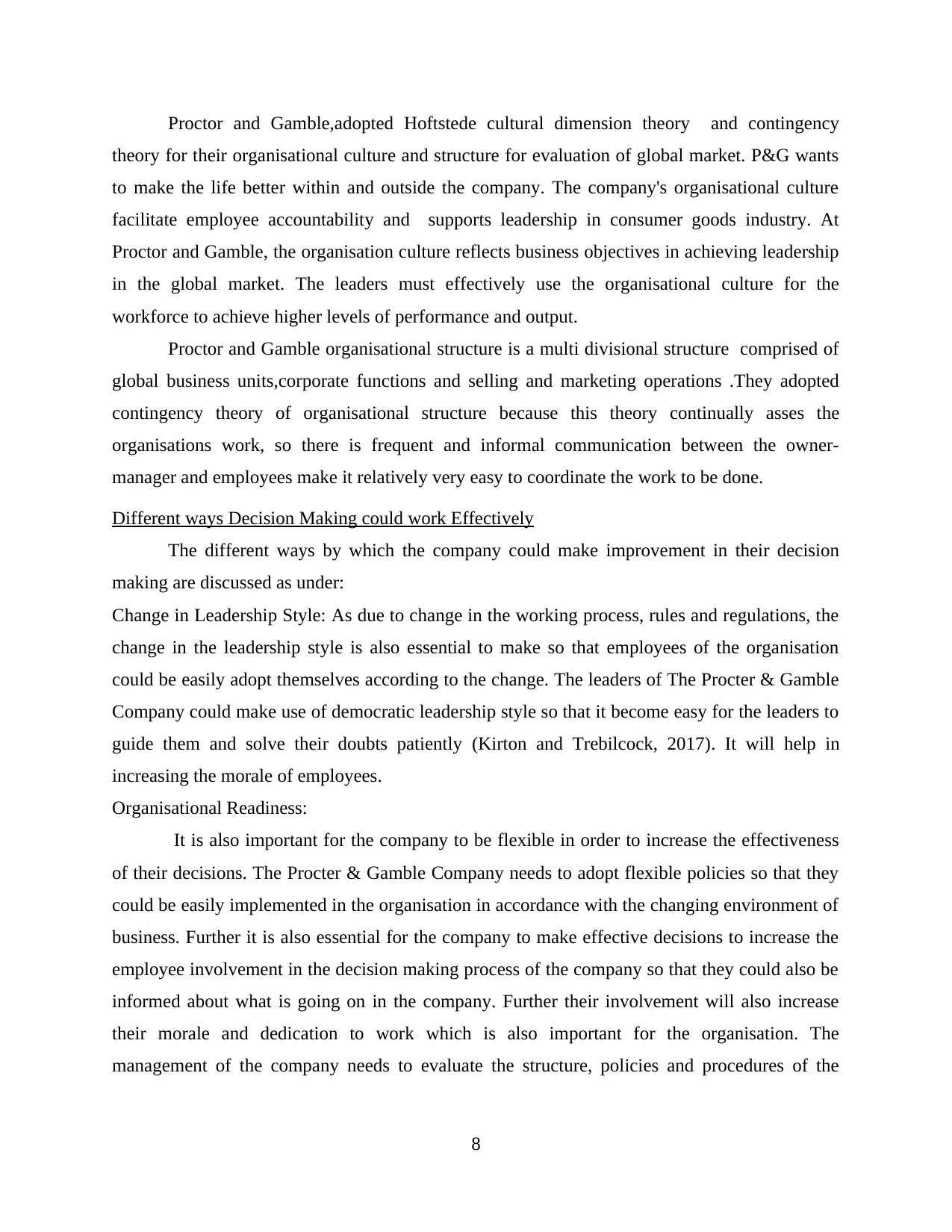
Proctor and Gamble,adopted Hoftstede cultural dimension theory and contingency
theory for their organisational culture and structure for evaluation of global market. P&G wants
to make the life better within and outside the company. The company's organisational culture
facilitate employee accountability and supports leadership in consumer goods industry. At
Proctor and Gamble, the organisation culture reflects business objectives in achieving leadership
in the global market. The leaders must effectively use the organisational culture for the
workforce to achieve higher levels of performance and output.
Proctor and Gamble organisational structure is a multi divisional structure comprised of
global business units,corporate functions and selling and marketing operations .They adopted
contingency theory of organisational structure because this theory continually asses the
organisations work, so there is frequent and informal communication between the owner-
manager and employees make it relatively very easy to coordinate the work to be done.
Different ways Decision Making could work Effectively
The different ways by which the company could make improvement in their decision
making are discussed as under:
Change in Leadership Style: As due to change in the working process, rules and regulations, the
change in the leadership style is also essential to make so that employees of the organisation
could be easily adopt themselves according to the change. The leaders of The Procter & Gamble
Company could make use of democratic leadership style so that it become easy for the leaders to
guide them and solve their doubts patiently (Kirton and Trebilcock, 2017). It will help in
increasing the morale of employees.
Organisational Readiness:
It is also important for the company to be flexible in order to increase the effectiveness
of their decisions. The Procter & Gamble Company needs to adopt flexible policies so that they
could be easily implemented in the organisation in accordance with the changing environment of
business. Further it is also essential for the company to make effective decisions to increase the
employee involvement in the decision making process of the company so that they could also be
informed about what is going on in the company. Further their involvement will also increase
their morale and dedication to work which is also important for the organisation. The
management of the company needs to evaluate the structure, policies and procedures of the
8
theory for their organisational culture and structure for evaluation of global market. P&G wants
to make the life better within and outside the company. The company's organisational culture
facilitate employee accountability and supports leadership in consumer goods industry. At
Proctor and Gamble, the organisation culture reflects business objectives in achieving leadership
in the global market. The leaders must effectively use the organisational culture for the
workforce to achieve higher levels of performance and output.
Proctor and Gamble organisational structure is a multi divisional structure comprised of
global business units,corporate functions and selling and marketing operations .They adopted
contingency theory of organisational structure because this theory continually asses the
organisations work, so there is frequent and informal communication between the owner-
manager and employees make it relatively very easy to coordinate the work to be done.
Different ways Decision Making could work Effectively
The different ways by which the company could make improvement in their decision
making are discussed as under:
Change in Leadership Style: As due to change in the working process, rules and regulations, the
change in the leadership style is also essential to make so that employees of the organisation
could be easily adopt themselves according to the change. The leaders of The Procter & Gamble
Company could make use of democratic leadership style so that it become easy for the leaders to
guide them and solve their doubts patiently (Kirton and Trebilcock, 2017). It will help in
increasing the morale of employees.
Organisational Readiness:
It is also important for the company to be flexible in order to increase the effectiveness
of their decisions. The Procter & Gamble Company needs to adopt flexible policies so that they
could be easily implemented in the organisation in accordance with the changing environment of
business. Further it is also essential for the company to make effective decisions to increase the
employee involvement in the decision making process of the company so that they could also be
informed about what is going on in the company. Further their involvement will also increase
their morale and dedication to work which is also important for the organisation. The
management of the company needs to evaluate the structure, policies and procedures of the
8
Paraphrase This Document
Need a fresh take? Get an instant paraphrase of this document with our AI Paraphraser
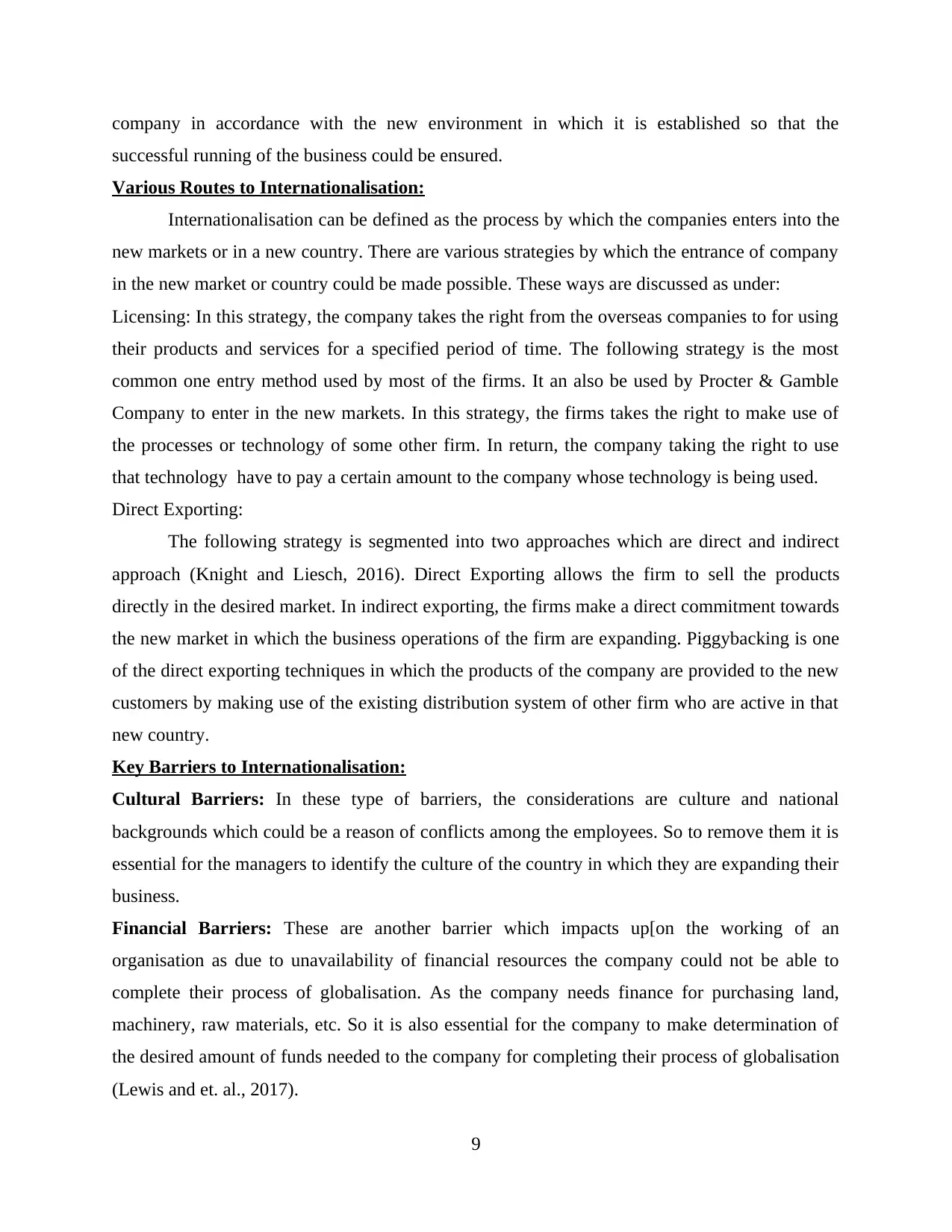
company in accordance with the new environment in which it is established so that the
successful running of the business could be ensured.
Various Routes to Internationalisation:
Internationalisation can be defined as the process by which the companies enters into the
new markets or in a new country. There are various strategies by which the entrance of company
in the new market or country could be made possible. These ways are discussed as under:
Licensing: In this strategy, the company takes the right from the overseas companies to for using
their products and services for a specified period of time. The following strategy is the most
common one entry method used by most of the firms. It an also be used by Procter & Gamble
Company to enter in the new markets. In this strategy, the firms takes the right to make use of
the processes or technology of some other firm. In return, the company taking the right to use
that technology have to pay a certain amount to the company whose technology is being used.
Direct Exporting:
The following strategy is segmented into two approaches which are direct and indirect
approach (Knight and Liesch, 2016). Direct Exporting allows the firm to sell the products
directly in the desired market. In indirect exporting, the firms make a direct commitment towards
the new market in which the business operations of the firm are expanding. Piggybacking is one
of the direct exporting techniques in which the products of the company are provided to the new
customers by making use of the existing distribution system of other firm who are active in that
new country.
Key Barriers to Internationalisation:
Cultural Barriers: In these type of barriers, the considerations are culture and national
backgrounds which could be a reason of conflicts among the employees. So to remove them it is
essential for the managers to identify the culture of the country in which they are expanding their
business.
Financial Barriers: These are another barrier which impacts up[on the working of an
organisation as due to unavailability of financial resources the company could not be able to
complete their process of globalisation. As the company needs finance for purchasing land,
machinery, raw materials, etc. So it is also essential for the company to make determination of
the desired amount of funds needed to the company for completing their process of globalisation
(Lewis and et. al., 2017).
9
successful running of the business could be ensured.
Various Routes to Internationalisation:
Internationalisation can be defined as the process by which the companies enters into the
new markets or in a new country. There are various strategies by which the entrance of company
in the new market or country could be made possible. These ways are discussed as under:
Licensing: In this strategy, the company takes the right from the overseas companies to for using
their products and services for a specified period of time. The following strategy is the most
common one entry method used by most of the firms. It an also be used by Procter & Gamble
Company to enter in the new markets. In this strategy, the firms takes the right to make use of
the processes or technology of some other firm. In return, the company taking the right to use
that technology have to pay a certain amount to the company whose technology is being used.
Direct Exporting:
The following strategy is segmented into two approaches which are direct and indirect
approach (Knight and Liesch, 2016). Direct Exporting allows the firm to sell the products
directly in the desired market. In indirect exporting, the firms make a direct commitment towards
the new market in which the business operations of the firm are expanding. Piggybacking is one
of the direct exporting techniques in which the products of the company are provided to the new
customers by making use of the existing distribution system of other firm who are active in that
new country.
Key Barriers to Internationalisation:
Cultural Barriers: In these type of barriers, the considerations are culture and national
backgrounds which could be a reason of conflicts among the employees. So to remove them it is
essential for the managers to identify the culture of the country in which they are expanding their
business.
Financial Barriers: These are another barrier which impacts up[on the working of an
organisation as due to unavailability of financial resources the company could not be able to
complete their process of globalisation. As the company needs finance for purchasing land,
machinery, raw materials, etc. So it is also essential for the company to make determination of
the desired amount of funds needed to the company for completing their process of globalisation
(Lewis and et. al., 2017).
9
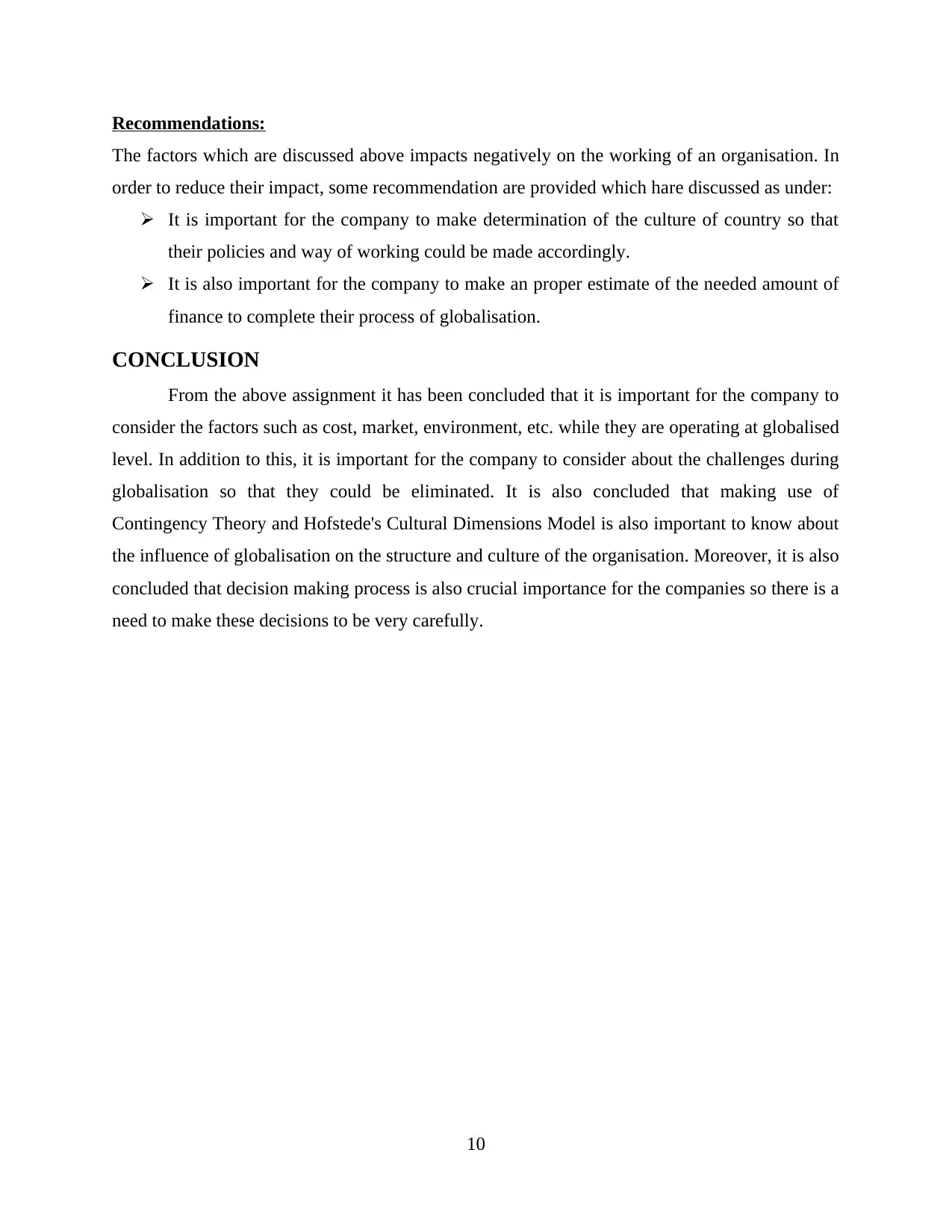
Recommendations:
The factors which are discussed above impacts negatively on the working of an organisation. In
order to reduce their impact, some recommendation are provided which hare discussed as under:
It is important for the company to make determination of the culture of country so that
their policies and way of working could be made accordingly.
It is also important for the company to make an proper estimate of the needed amount of
finance to complete their process of globalisation.
CONCLUSION
From the above assignment it has been concluded that it is important for the company to
consider the factors such as cost, market, environment, etc. while they are operating at globalised
level. In addition to this, it is important for the company to consider about the challenges during
globalisation so that they could be eliminated. It is also concluded that making use of
Contingency Theory and Hofstede's Cultural Dimensions Model is also important to know about
the influence of globalisation on the structure and culture of the organisation. Moreover, it is also
concluded that decision making process is also crucial importance for the companies so there is a
need to make these decisions to be very carefully.
10
The factors which are discussed above impacts negatively on the working of an organisation. In
order to reduce their impact, some recommendation are provided which hare discussed as under:
It is important for the company to make determination of the culture of country so that
their policies and way of working could be made accordingly.
It is also important for the company to make an proper estimate of the needed amount of
finance to complete their process of globalisation.
CONCLUSION
From the above assignment it has been concluded that it is important for the company to
consider the factors such as cost, market, environment, etc. while they are operating at globalised
level. In addition to this, it is important for the company to consider about the challenges during
globalisation so that they could be eliminated. It is also concluded that making use of
Contingency Theory and Hofstede's Cultural Dimensions Model is also important to know about
the influence of globalisation on the structure and culture of the organisation. Moreover, it is also
concluded that decision making process is also crucial importance for the companies so there is a
need to make these decisions to be very carefully.
10
⊘ This is a preview!⊘
Do you want full access?
Subscribe today to unlock all pages.

Trusted by 1+ million students worldwide
1 out of 13
Related Documents
Your All-in-One AI-Powered Toolkit for Academic Success.
+13062052269
info@desklib.com
Available 24*7 on WhatsApp / Email
![[object Object]](/_next/static/media/star-bottom.7253800d.svg)
Unlock your academic potential
Copyright © 2020–2025 A2Z Services. All Rights Reserved. Developed and managed by ZUCOL.



